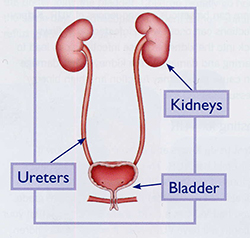What is bladder outlet obstruction?
 Bladder outlet obstruction is a blockage at the base of the bladder that reduces or prevents the flow of urine into the urethra, the tube that carries urine out of the body.
Bladder outlet obstruction is a blockage at the base of the bladder that reduces or prevents the flow of urine into the urethra, the tube that carries urine out of the body.
What causes bladder outlet obstruction?
The three most common causes of a distended bladder in a male fetus relate to birth defects involving the urinary tract:
-
posterior urethral valves
-
megacystis-microcolon
If the bladder does not empty, then the kidneys may also have difficulty draining and therefore expand. This can affect kidney development and function.
How is bladder outlet obstruction detected?
Antenatal (before birth) hydronephrosis (fluid-filled enlargement of the kidney) is detected in the fetus by ultrasound studies performed as early as the first trimester of pregnancy. This is identified in 1 percent of male fetuses and 0.5% of females during pregnancy.
Typically this is an isolated finding and is not associated with abnormalities in other organ systems. Most of the enlargement is mild and does not affect the timing or site of delivery.
What is the frequency?
Obstruction of the bladder outlet or urethra can be identified in up to 1 in 5000 male infants. This type of obstruction almost never occurs in female infants.












